|
|
|
Sort Order |
|
|
|
Items / Page
|
|
|
|
|
|
|
| Srl | Item |
| 1 |
ID:
132371
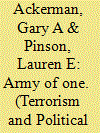

|
|
|
|
|
| Publication |
2014.
|
| Summary/Abstract |
In recent years, much of the literature on terrorist pursuits and use of unconventional weapons has focused on al-Qaeda and other Islamic extremist groups. Some scholars posit lone actors may differ from organizations when it comes to the observation that larger organizations are more likely to engage in chemical, biological, radiological, and nuclear (CBRN) activity, but leave this as an open question because of a prior lack of data on lone actors. Furthermore, new technologies and expanding networks may also spawn more deleterious lone actors, including what have been referred to as "super-empowered individuals." This article utilizes the Profiles of Incidents Involving CBRN by Non-State Actors Dataset and the Radiological and Nuclear Non-State Actors Database to illustrate the characteristics of CBRN pursuit by lone wolves and autonomous cells over time. Initial findings confirm the general perceptions that, historically, lone actors have engaged in cruder, smaller scale, and less frequent CBRN plots and attacks than their formal terrorist organization counterparts, but suggest that such actors do present a genuine threat, at least in terms of the potential for mass disruption. Additionally, while they share several similarities with more formal organizations, lone actors and autonomous cells tend to be motivated less by collective religious or ethno-nationalist concerns than larger organizations, focusing more on narrow or solipsistic drivers. Lone actors and autonomous cells also appear to largely calibrate their CBRN ambitions to their capabilities and their CBRN actions tend to receive better media coverage than formal terrorist organizations.
|
|
|
|
|
|
|
|
|
|
|
|
|
|
|
|
| 2 |
ID:
172053
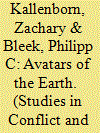

|
|
|
|
|
| Summary/Abstract |
Terrorists combining motivations and capabilities to conduct significant chemical, biological, radiological, or nuclear (CBRN) attacks are, logically and empirically, outliers. Certain characteristics of radical environmentalism heighten the risk of such outliers. The majority of even radical environmentalists embrace nonviolence. Those who turn violent mostly do so in limited ways due to a combination of motivations and capabilities. Fringe elements are motivated to commit large-scale—including CBRN—violence, but are mostly constrained by capability. Yet eco-radicalism also draws more capable adherents. If serious CBRN terrorism attacks occur—a risk about which analysts differ markedly—radical environmentalist fringe actors are plausible perpetrators.
|
|
|
|
|
|
|
|
|
|
|
|
|
|
|
|
| 3 |
ID:
092304
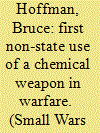

|
|
|
|
|
| Publication |
2009.
|
| Summary/Abstract |
This article presents research conducted by the author in Sri Lanka to verify the first non-state use of a chemical weapon in warfare. This 1990 incident involved a primitive chemical attack perpetrated by the Liberation Tigers of Tamil Eelam (the LTTE or Tamil Tigers) on a Sri Lankan Armed Forces (SLAF) encampment in East Kiran, in the Batticaloa district of Sri Lanka. The article first describes the incident itself, before providing a brief description of the LTTE, its background, and the influence of its leader, Velupillai Prabhakaran. The article then analyzes the attack and places it within the context of theories about potential terrorist and insurgent use of unconventional weapons, such as chemical warfare agents. The research reported here is of interest not only because of the unique, opportunistic dimension of the attack, but also because its conclusions challenge the conventional wisdom about likely terrorist and insurgent use of these unconventional weapons and sheds new light on their interest and intentions in employing such weapons and tactics.
|
|
|
|
|
|
|
|
|
|
|
|
|
|
|
|
| 4 |
ID:
100655


|
|
|
| 5 |
ID:
050812


|
|
|
|
|
| Edition |
2nd ed.
|
| Publication |
Surrey, Jane's Information Group, 2004.
|
| Description |
314p.
|
| Standard Number |
07106257415
|
|
|
|
|
|
|
|
|
|
|
|
Copies: C:1/I:0,R:0,Q:0
Circulation
| Accession# | Call# | Current Location | Status | Policy | Location |
| 047807 | 615.9/DWY 047807 | Main | On Shelf | General | |
|
|
|
|
| 6 |
ID:
127410
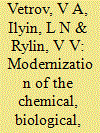

|
|
|
|
|
| Publication |
2013.
|
| Summary/Abstract |
The authors make a case for the need to develop chemical, biological, and radiological (CBR) protection in the emerging political, military, and economic situation; they also consider the possible effect of destruction of, or accidents at, chemically, biologically, or radiologically hazardous facilities on the behavior of troops and on the protection of the population and territories.
|
|
|
|
|
|
|
|
|
|
|
|
|
|
|
|
| 7 |
ID:
130735
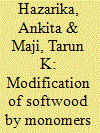

|
|
|
|
|
| Publication |
2014.
|
| Summary/Abstract |
Technological development of wood polymer composites (WPC) is a very promising approach to overcome most of the disadvantageous properties of wood products, for example their poor mechanical strength, poor dimensional stability, susceptibility to fungal attack, weathering and the like. To find the substitute for costly items of hard wood, suitable technologies have been developed to modify softwood to meet specific end-use requirements. Various vinyl monomers and/or copolymers or thermosetting resin in combination with different types of cross linking agents, flame retarding agents have been used to improve the properties of wood. Nanotechnology is a new area of science and technology which opens up new opportunities to develop wood based products with desired properties. Now-a-days government is making strict legislations to promote green technology for the protection of environment world wide. With the depletion of petroleum resources at alarming rate, it is high time to replace petroleum-based products by some sustainable alternative products based on vegetable biomass. The bio-based resins obtained from renewable feedstock have been widely utilized by taking the advantages of easy availability, renewable nature and low cost. The green route of modification of wood is widely encouraged. With the progress of technological development, now it is possible to avoid the hazardous influence of organic solvents by using water as solvent or diluents formodification of wood. WPC has got tremendous scope for use in diverse areas of applications.
|
|
|
|
|
|
|
|
|
|
|
|
|
|
|
|
| 8 |
ID:
150403
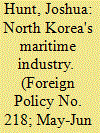

|
|
|
| 9 |
ID:
084939


|
|
|
|
|
| Publication |
2008.
|
| Summary/Abstract |
The collapse of the Soviet Union raised concerns about the fate of its nuclear weapons and led the United States to fund what came to be known as Cooperative Threat Reduction (CTR). This includes programs that fight the proliferation of weapons expertise by providing short-term income and eventual re-employment of former Soviet WMD experts in civilian fields. Using case studies, based on archival research and extensive interviews, this article argues that CTR's three main 'knowledge non-proliferation' efforts have largely failed at their given task. Although programs have worked with many former Soviet WMD experts, few have been re-employed. Each program has also come to emphasize the number of people engaged rather than re-directed and to have less regard for their WMD skills. Moreover, this shift in goals, and the metrics each program uses to measure progress, led to serious political disputes between Moscow and Washington. Besides being unable to demonstrate success at their original non-proliferation goals, these programs use metrics that threaten to upset the fragile US domestic political consensus for future work in Russia.
|
|
|
|
|
|
|
|
|
|
|
|
|
|
|
|
| 10 |
ID:
141595
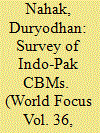

|
|
|
|
|
| Summary/Abstract |
Despite tense atmosphere that continues to prevail between India and Pakistan since Mumbai terror plot 2008, the hopes to build an atmosphere of peace and confidence between them have not been jettisoned. Their relations are marred by confrontation, crisis, and conflict but they have agreed upon and signed a great deal of CBMs since Independence. In the era of nuclear, chemical and cruise missile in the hands of nation states in general, and India and Pakistan in particular, CBMs seem to be alternative weapons to guarantee peace and security in the interest of humanity. In initial years of partition, the challenges for the political leadership of both the countries were many, for that purpose, they had put their endeavours to resolve all the minor disputes arising out of partition.
|
|
|
|
|
|
|
|
|
|
|
|
|
|
|
|
|
|
|
|
|